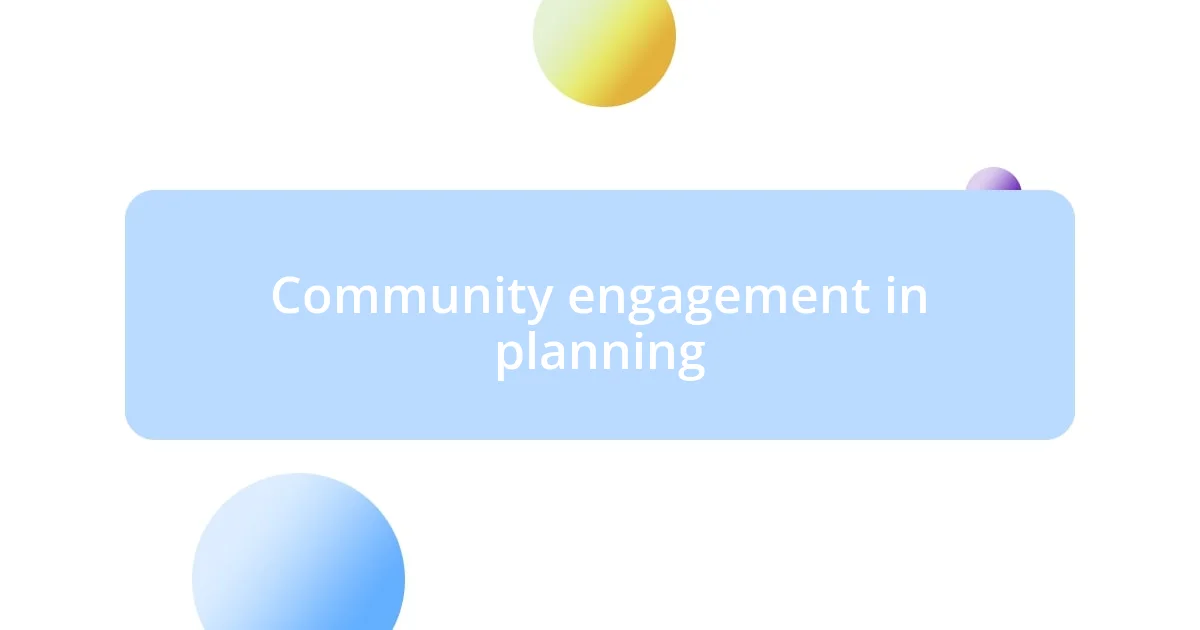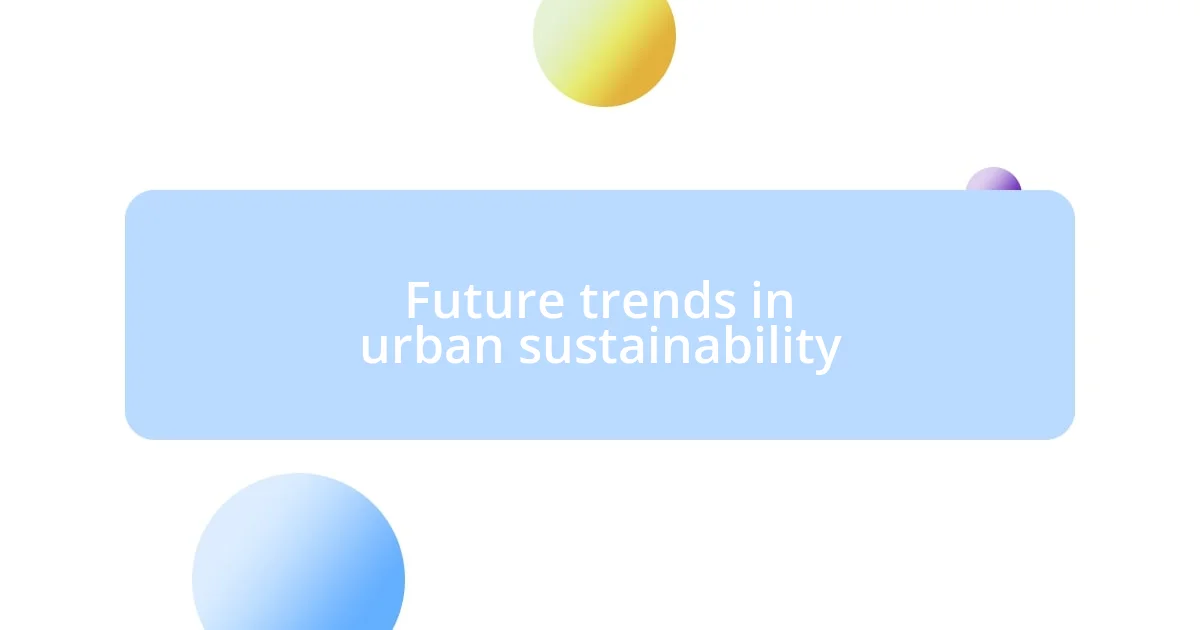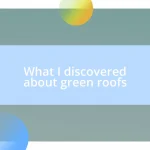Key takeaways:
- Sustainable urban planning integrates green spaces, mixed-use developments, and community engagement to foster healthier, more connected urban environments.
- Key principles of sustainability include resource efficiency, social equity, and ecological integrity, which collectively enhance quality of life and community cohesion.
- Future trends like biophilic design, decentralized energy systems, and urban agriculture initiatives are essential for promoting sustainable living and resilient communities.

Understanding sustainable urban planning
Sustainable urban planning is not just a concept; it’s a necessity for our future. I remember walking through a city that seamlessly integrated green spaces with urban life. It struck me how those parks were not merely decorative; they were essential for mental health, community gathering, and biodiversity. Isn’t it fascinating how a thoughtful design can transform urban living?
At its core, sustainable urban planning focuses on creating spaces that meet the needs of the present without compromising the ability of future generations to meet their own needs. This philosophy goes beyond the physical layout of a city; it encompasses social equity, environmental responsibility, and economic viability. I often wonder how many decisions made today will ripple out to affect our children and grandchildren.
One striking example is the movement towards mixed-use developments, where residential, commercial, and recreational facilities coexist. This approach not only reduces the reliance on cars but also fosters a sense of community. When I visited a neighborhood that embraced this model, I felt an invigorating energy in the air. It seemed that everyone was connected, contributing to a vibrant urban tapestry. Isn’t that the kind of community we should strive for?

Key principles of sustainability
Sustainable urban planning is anchored in several key principles, one of which is resource efficiency. I recall my visit to a sustainable community where solar panels adorned rooftops, dramatically lowering energy costs. It was inspiring to see how simple technological advancements significantly minimized the carbon footprint while enhancing residents’ quality of life. This experience reinforced my belief that utilizing resources wisely is a cornerstone of sustainability.
Another vital principle is social equity, which promotes inclusivity and access for all. During my time in a co-housing project, I was struck by the diverse mix of families and individuals living together. Each resident had a voice in community decisions, fostering a sense of belonging and mutual respect. This commitment to building communities that serve everyone speaks volumes about the collective strength we can achieve through sustainability efforts.
Finally, the principle of ecological integrity ensures that urban development harmonizes with nature. I once explored an eco-district that integrated wildlife corridors into its design, allowing animals to thrive alongside people. Witnessing the natural ecosystem thriving amid urbanization was a poignant reminder of our responsibility to protect the environment. It’s stimulating to think about how such design practices can create a synergy between urban life and nature.
| Principle | Description |
|---|---|
| Resource Efficiency | Focuses on minimizing waste and utilizing sustainable technologies. |
| Social Equity | Ensures all community members have access to resources and voice in decision-making. |
| Ecological Integrity | Aims to align urban environments with natural ecosystems for holistic health. |

Benefits of green spaces
Green spaces offer profound benefits that often go unnoticed in the hustle of urban life. I remember sitting in a park one sunny afternoon, surrounded by trees and laughter. The air felt lighter, and I could sense my stress melting away. Those moments of tranquility highlight the psychological advantages of greenery, which can significantly reduce anxiety and enhance overall well-being.
Here are some key benefits of green spaces in urban settings:
- Improved Air Quality: Plants filter pollutants and produce oxygen, making our cities healthier places to live.
- Enhanced Community Interaction: Parks serve as social hubs, fostering connections among diverse groups and promoting community spirit.
- Biodiversity Conservation: Green spaces create vital habitats for urban wildlife, ensuring the survival of various species.
- Physical Activity Encouragement: Accessible parks encourage walking, jogging, and play, fostering healthier lifestyles for residents.
- Economic Value: Proximity to green spaces often increases property values, benefiting the local economy.
Experiencing the vibrant life of that park firsthand left a lasting impression on me. It’s remarkable how such simple spaces can lift our spirits and enrich our communities. When I see children playing and families picnicking, I am reminded of the intrinsic value these areas bring—not just to nature, but to our collective urban experience. They truly are the beating heart of sustainable cities.

Community engagement in planning
When it comes to community engagement in planning, I’ve found that it’s absolutely crucial for creating spaces that resonate with the people living in them. There was a local town meeting I attended where residents passionately voiced their ideas and concerns about a new park. I was struck by the diverse opinions—young parents wanted safe play areas, while seniors emphasized the need for quiet spaces. This kind of dialogue not only ensures that the planning reflects community needs, but it also fosters a sense of ownership among residents.
I remember another instance where a neighborhood survey influenced the revitalization of a previously neglected space. The community gathered to share their thoughts, and to my surprise, many residents had creative suggestions for art installations and community gardens. It was inspiring to see how their excitement translated into tangible changes. Engaging people in this way transforms planning from a top-down approach to a collaborative effort, allowing everyone to feel invested in the outcome.
Ultimately, I believe community engagement also nurtures social connections. When people come together, whether in workshops or informal gatherings, they develop relationships that extend beyond project discussions. Those bonds create a community spirit that isn’t just about shared spaces but about shared lives. Does it make you reflect on how your own local projects could benefit from greater involvement? For me, embracing this collective wisdom is one of the most rewarding aspects of sustainable urban planning.

Innovative technologies in urban design
Incorporating innovative technologies into urban design can truly transform the way we interact with our cities. I recall visiting a smart city initiative where sensors in streetlights adjusted brightness based on pedestrian movement. It was fascinating to witness how technology not only enhanced safety but also reduced energy consumption. Isn’t it amazing to think about how these small changes can accumulate into significant environmental benefits?
On another occasion, I explored a neighborhood that utilized augmented reality (AR) to visualize proposed developments. As residents donned AR glasses, they could see how new buildings might integrate with their current surroundings. It struck me how engaging this technology was; people were visibly excited to contribute their thoughts, realizing they could shape their urban landscape in real time. Have you ever thought about how much more involved and informed you’d feel if you could visualize changes before they occur?
Technologies like 3D printing are also making waves in urban design by allowing rapid prototyping of building elements. I attended a workshop where architects showcased how they could produce affordable housing components in days, rather than months. Witnessing the tangible results of such advanced techniques made me ponder: How might this shift in production methods redefine our approach to sustainable living? The fusion of creativity and technology in urban planning opens doors to solutions we might not have even imagined a few years ago.

Case studies of successful projects
One of my favorite case studies is the Green Roof Initiative in Toronto. I vividly remember walking through the city and noticing buildings that transformed their rooftops into lush gardens. It was striking to see how these green spaces not only provided habitats for birds and insects but also helped reduce urban heat. Have you ever imagined how revitalizing a rooftop can create a miniature ecosystem in the heart of a busy city? It changed my perspective on underutilized spaces and how they can contribute to sustainability.
Another inspiring project is the 15-Minute City model being implemented in Paris. I had the chance to explore various neighborhoods where amenities are just a short walk or bike ride away. This concept resonated with me; it promotes a higher quality of life while significantly reducing reliance on cars. I saw families enjoying playgrounds, neighbors chatting over coffee, and people embracing a slower pace of life. It made me reflect—what if my city adopted such an approach? The idea that accessibility can shape community well-being is powerful.
One project I’ve closely followed is the High Line in New York City. I remember visiting this elevated park, where old rail tracks became a vibrant public space filled with art, greenery, and stunning views. The transformation left me in awe—seeing how a neglected infrastructure could breathe new life into a neighborhood speaks to the potential of creative revitalization. It posed the question: how can we repurpose our existing urban assets to create something beautiful and functional? Projects like these remind me of the endless possibilities in sustainable urban planning.

Future trends in urban sustainability
I believe the future of urban sustainability hinges significantly on the integration of biophilic design. When I visited a recent exhibit on this topic, I was struck by installations that incorporated natural elements into urban spaces, fostering a better connection between people and nature. It made me wonder—how can we bring more greenery into our cities to enhance well-being while simultaneously addressing air quality issues? I left the exhibit inspired by the realization that even small elements like vertical gardens can transform concrete jungles into thriving ecosystems.
Another trend I’m excited about is the rise of decentralized energy systems. While touring a community that embraced solar microgrids, I felt a palpable sense of empowerment among residents. They shared stories of how controlling their energy sources not only reduced their carbon footprint but also fostered a sense of unity. I couldn’t help but think—what if more neighborhoods adopted this model? The collective effort could lead to a significant reduction in our reliance on fossil fuels, paving the way for sustainable urban living.
Finally, I see a growing importance in urban agriculture initiatives. A visit to a community garden opened my eyes to how these spaces offer fresh produce while also acting as social hubs. It was heartwarming to watch diverse groups come together, sharing knowledge and labor. How incredible would it be if every urban area prioritized access to local food sources? This connection to food not only promotes sustainability but also nurtures community bonds, which I believe is essential for fostering resilient cities.













